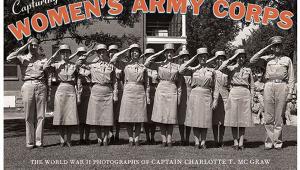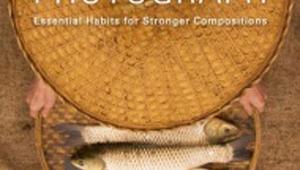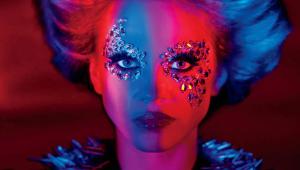Photographing Shadow And Light: Inside The Dramatic Lighting Techniques And Creative Vision Of Portrait Photographer Joey L.

Photographing Shadow and Light starts with Joey’s overall philosophy and basic approach, then goes behind the scenes at more than 15 shoots, from personal fine art projects in Africa, India, and Brooklyn, New York, to commercial shoots for the Jonas Brothers, 50 Cent, and more. For each shoot, readers learn how Joey visualized the concept, formed meaningful connections with his subjects, and, most important, “built” his signature dramatic lighting effects, one light at a time. The result is a comprehensive guide to contemporary portraiture from a photographer on the cutting edge of the field.
Featuring more than 85 stunning portraits and a foreword by Strobist.com’s David Hobby, this book offers photographers an insider’s guide to creating more dramatic photos.—Liner notes supplied by the publisher.
Many how-to lighting and posing books come across our desk, but this one stood out with its comprehensive discussion of how numerous exciting images were made. Throughout this 176-page book Joey L. brings his work to life and along the way teaches numerous valuable lessons in seeing, setups, and lighting. We chose this excerpt as a prime example of what the book has to offer.—Editor
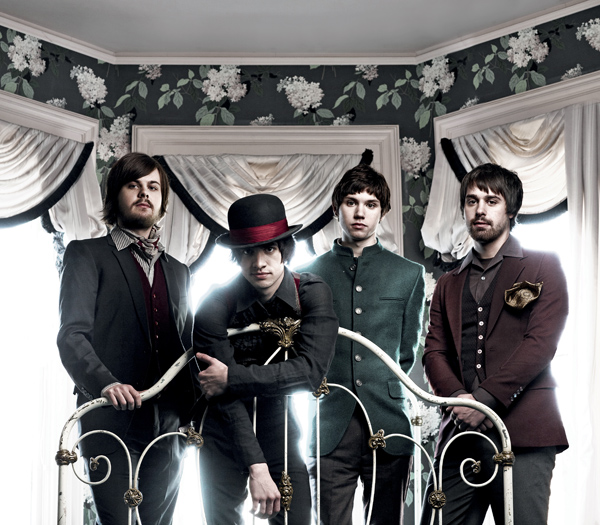
Panic At The Disco
This editorial shoot for Alternative Press magazine is a great example of a fast-moving session in which I needed to work quickly and move my subjects from one predesigned setup to another. I designed three lighting configurations for three different rooms in the house. As we were shooting in one room, my crew would be setting up in another. When we’d switch to that room, they’d break down the setup in the room in which we just shot, and then set up the third configuration so we could move seamlessly into it when we were ready.
There wasn’t an art director from the magazine on set, but there was a manager from the band’s label, which actually funded half the shoot because they knew it would produce good press for the band. Still, I had a good amount of artistic freedom on this project since the label is primarily interested in upholding the band’s image and promoting its brand. Beyond that, I was free to try a few different things and create my own looks, as long as they synched with the band’s style. The band favors vintage fashion, so we chose a location that worked with this style. A cohesiveness between their style and the location was important to these images. Also, I wanted to include painterly lighting effects with an almost regal feel.


Making It Happen
We staged the shoot in a 120-year-old house near Los Angeles, which I found through a location directory. Location directories are very handy tools for photographers who need a specific look from their settings. These online directories contain a wide assortment of spots that location scouts have previewed for film, television, and advertising projects. They can give you an inside look at dozens of otherwise hidden locations without spending hundreds of hours scouting them out yourself.
I chose this location because it had a vintage feel that matches Panic at the Disco’s style. The house also had an eclectic design, with each room looking different from the next and providing a variety of shooting options.
Panic has a stylist who travels with the band and chooses their clothing for appearances and promotional projects, including this photo shoot. During the shoot, I would tell her what the next shot would be, show her the room and the setup, and she would dress them accordingly. It’s important to advise the stylists on commercial shoots, so the subjects’ clothing coordinates with the scenes and doesn’t ruin the feel of the images. For example, in a dark and somber shot, like the Panic image in the red room, if one of the band members had been wearing a bright white shirt, the image probably wouldn’t have worked.
For the backlit image I lay down on the ground with my camera set up on a splayed-out tripod in the doorway of the room. Aiming up at the band from this low angle, I framed the shot to show the top half of the bed frame and the band members from about the knees up. The band was standing inside the bed frame (there was no mattress or box springs), so I could shoot through the metal frame without any significant obstruction to my subjects or the window light behind them.
Because of the strong window light backlighting my subjects, I only added one artificial light, a Profoto flash head in a big softbox, which I set up high to camera right. With the softbox aimed down at the subjects, I flashed on relatively low power to provide a bit of fill light, so the front sides of my subjects wouldn’t be completely obscured by shadow. To soak in as much natural window light as possible, I dragged my shutter a little. This caused the light to wrap around the subjects and flare a bit, while the guys in the foreground stayed a touch darker. I could have achieved the same effect by blasting studio flashes through the window and exposing for that light source, without the shutter drag. However, the light was already there, and it looked great, so I chose to tripod-mount the camera and make a longer exposure. When dragging the shutter to accent background lighting, your subjects need to stay as still as possible. Also, it’s best to lock your camera on a tripod or some other stable mount to eliminate camera shake.
Because we were working in a tight space, I posed the guys close together and had the band members on the outside turn their shoulders in toward the others. In general, when working in a compact space or trying to tighten up a group composition, it helps to pose the outer members of your group with their shoulders turned in toward the center. This draws the viewer’s eye toward the middle of the composition, and makes the group appear more compressed.
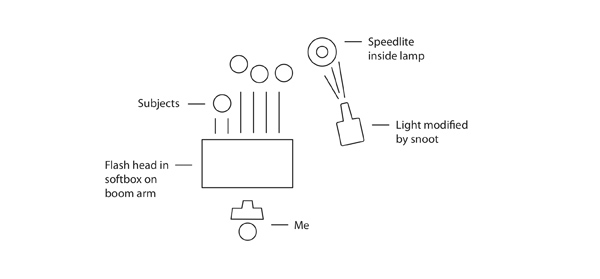
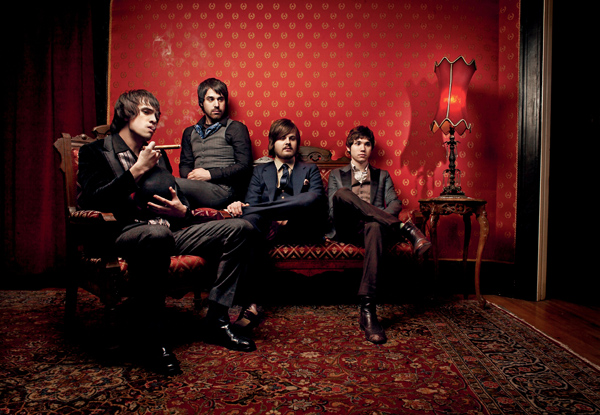
I used a long 85mm prime lens to accent the light in the background. When you use longer lenses, the background looks bigger, as does any light source in the background. On the other hand, when you use wide-angle lenses, the background looks smaller. Think of photographing a person with a mountain in the background. With a wide-angle lens, that mountain will look distant and small. With a long lens, the background will appear much larger and closer to the subject. You won’t see as much of it, but it will be magnified. Light sources in the background are also magnified by long lenses. So if you want to bring in a strong backlight and some intentional flare, a longer lens is the way to go. Because I wanted some flare from the window light, I shot from a little farther away with a longer lens. This increased the size of the background in the image and also increased the size and impact of the flare.
With the red room image, I wanted to capture the look of a Victorian painting. I set up the composition and lighting to create the feel of a painting—dark and moody, as opposed to a super bright, crisp commercial photograph.
My main light was a Profoto Pro flash head modified by a softbox, hooked up to a boom arm, which I arranged high above the band to camera left. I aimed the softbox down at about a 45-degree angle. This produced a dramatic appearance with strong shadows, which match the dark room and clothing styles. For a little extra punch, I hid a Canon Speedlite EX inside the lamp. I also pointed another light, modified by a snoot, at the lamp. If you look at the wall behind the lamp, there’s a circular glow. That’s from the snoot.
My panic at the disco camera bag
Camera: Canon EOS-1Ds Mark III
Lenses: 85mm F1.2L lens for backlit shot; 24–70mm F2.8 lens for red interior image
Lights: Profoto Pro flash heads and a Canon Speedlite EX
Light modifiers: Chimera softboxes, snoots, and grids
Power source: Profoto Pro-7a battery pack
Where To Buy
Photographing Shadow and Light: Inside the Dramatic Lighting Techniques and Creative Vision of Portrait Photographer Joey L. (ISBN: 978-0-8174-0014-9) by Joey L.
Amphoto Books; $29.99; paperback.
The book can be purchased online at amazon.com, barnesandnoble.com, or wherever books are sold.
About The Author
Joey L. is one of the photography industry’s most acclaimed young names. His client list includes Verizon, Nickelodeon, History Channel, A&E, FX Channel, Smirnoff, Coca-Cola, Pennzoil, Kawasaki, National Geographic Channel, Summit Entertainment, Forbes, Services for the Underserved, the Government of Abu Dhabi, and many more. He has been featured in Professional Photographer and Digital SLR magazines, and on Eyemazing, MTV.com, National Public Radio, NBC’s Last Call with Carson Daly, and The Hour with George Stroumboulopoulos. A one-hour documentary sharing Joey’s journey to photograph endangered tribes in Ethiopia, called Faces of a Vanishing World, airs on television networks worldwide. Joey lectures and teaches workshops at PPA, Gulf Photo Plus, and Imaging USA. His portfolio can be found at www.JoeyL.com, and his online educational tutorials at www.learnfromjoey.com.
David Hobby (Foreword) was a photojournalist for 20 years before launching Strobist.com, one of the world’s most popular photography blogs. He lives in Columbia, Maryland.



